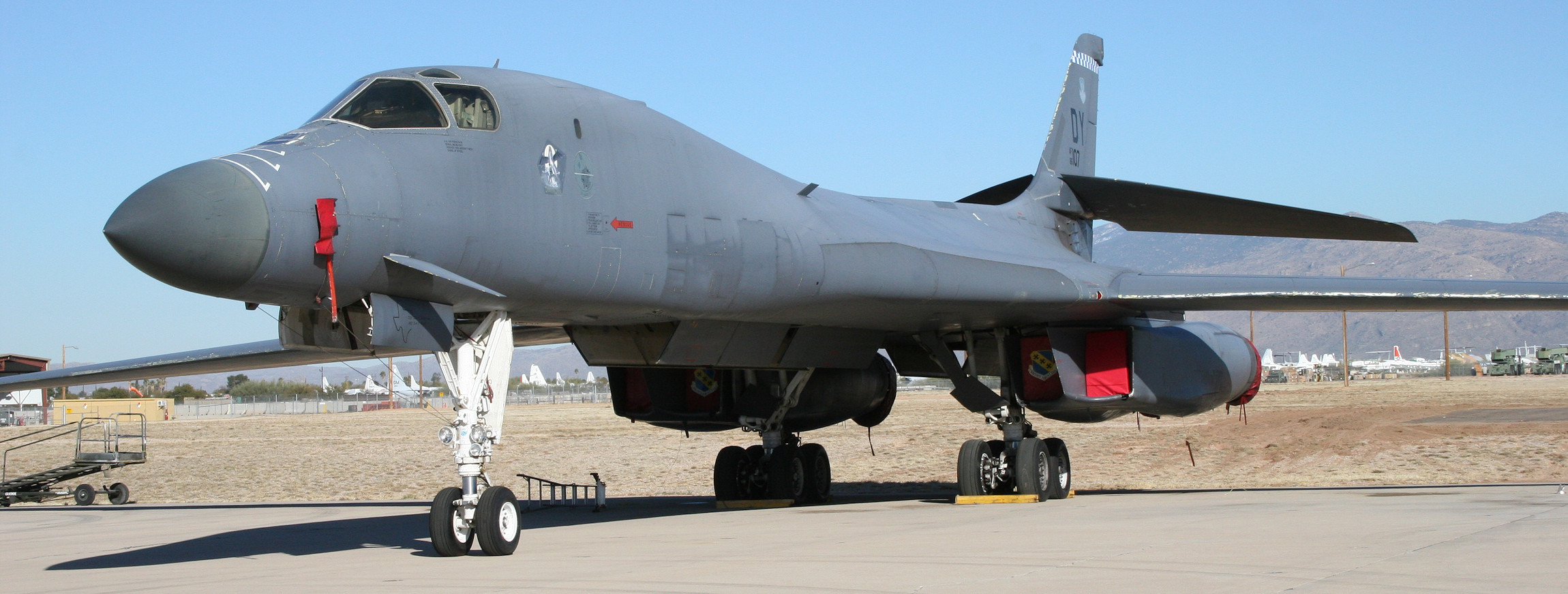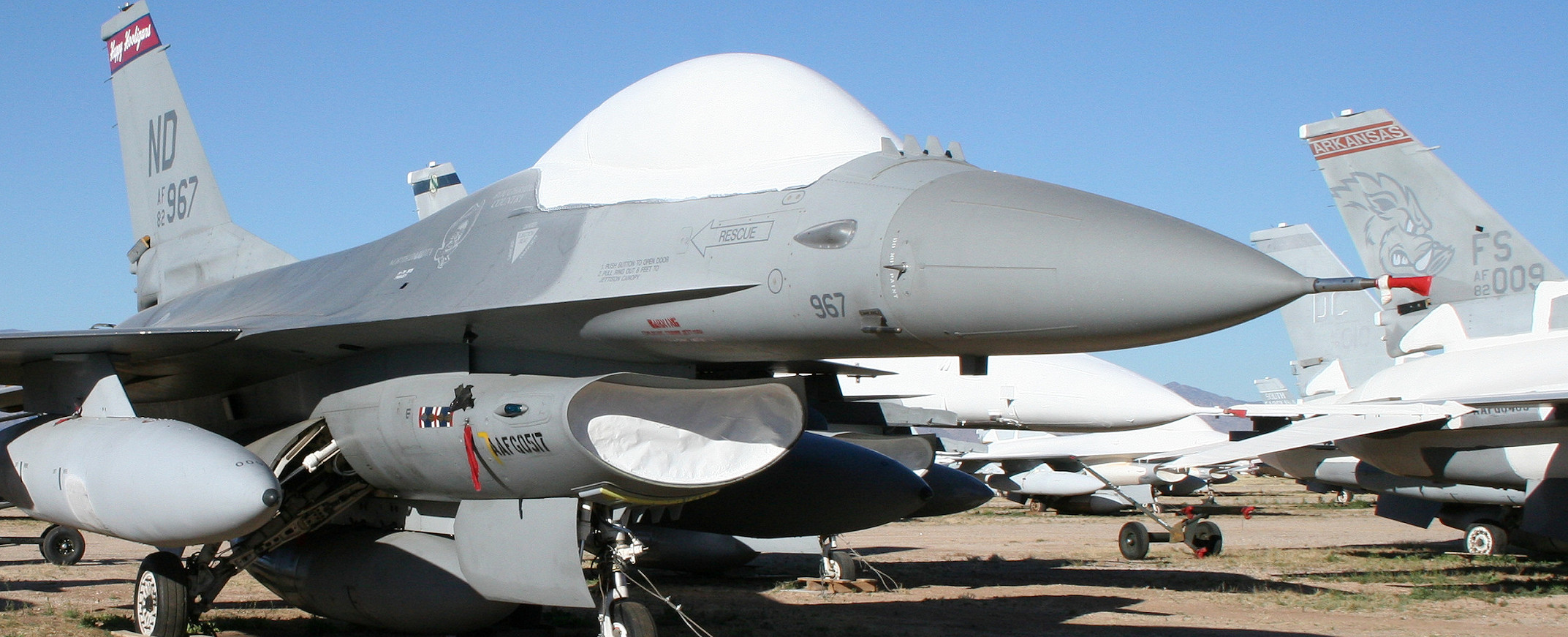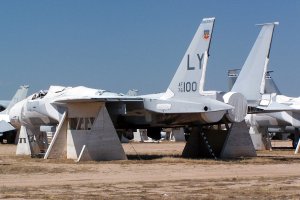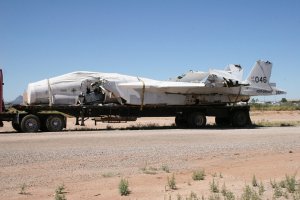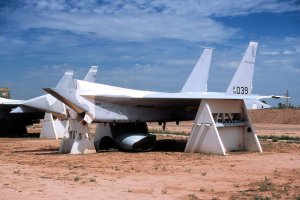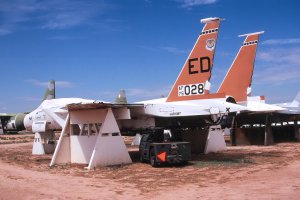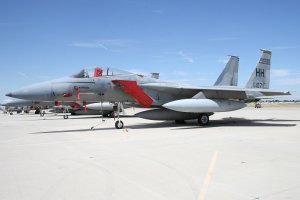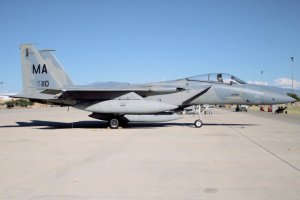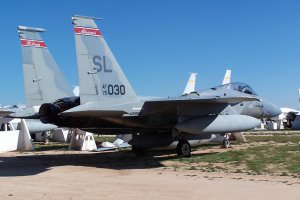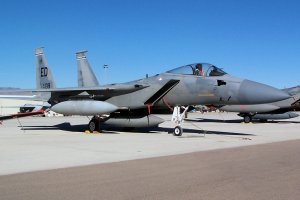Early Retirements
The McDonnell Douglas F-15 Eagle has been a familiar sight at AMARC & AMARG since the early 1990s. From July 1991 to the end of 1995 115 F-15As and 10 F-15Bs (the two seat version of the A) were retired to AMARC as a result of the drawdown of US military resources at that time and the introduction of the more modern/advanced F-15C/D models into the active duty Air Force fighter squadrons. Many of the F-15A/B aircraft which were previously operated by these squadrons were transfered to a number Air National Guard units to replace the McDonnell Douglas F-4 Phantoms they were operating up until that time.
Before these events, in 1983, McDonnell Douglas and the Air Force agreed on the development of two Multistage Improvement Programs (MSIP) for the F-15, named 'MSIP I' and 'MSIP II'. These programs were designed to upgrade the F-15 in most areas including radar and avionics, improved countermeasures, armament (including the AIM-120 Advanced Medium Range AAM (AMRAAM), the modern follow-on to the Sparrow missile), engines and stronger landing gear.
McDonnell Douglas F-15A Eagle 76-0100. Before retirement this F-15A served with the 48th Fighter Interceptor Squadron based at Langley AFB, VA. © Phil Kovaric.
McDonnell Douglas F-15A Eagle 75-0046. Having supplied spare parts to keep operational F-15s flying the hulk of the aircraft is being trucked off for scrapping and recycling at a local metal processing facility. © Phil Kovaric.
McDonnell Douglas F-15A Eagle 76-0039. A good demonstration of how much can be reclaimed from a retired aircraft. © Phil Kovaric.
McDonnell Douglas F-15A Eagle 75-0028, one of the more colorful F-15s in the RIT area. Before retirement this aircraft served with the 412th Test Wing, Edwards AFB, CA. © Phil Kovaric.
Due to the projected costs of MSIP I, which was aimed at the F-15A/B, it was cancelled but the MSIP II program, which was developed for the F-15C/D fleet, proceeded. A number of F-15A/Bs were provided with a subset of the MSIP II upgrades including such items as the stronger landing gear of the F-15C/D, F100-PW-220E engines, and improved Raytheon AN/APG-63(V)1 radar. However, a large number of the F-15A/Bs were deemed to not be suitable for the upgrades and were retired from service.
Some of those retired F-15 went to museums, some became gate guards, but the vast majority were sent to AMARC. At their time of retirement some of these aircraft were only 15 years old, a relatively young age compared with some of the types that have retired to AMARC over the years. Almost immediately the majority of these early AMARC F-15 examples were moved to over to the reclamation areas of the base and yielded spare parts which are introduced back into the active Air Force and Air National Guard inventories. By the early 2000s most of these early retirees were reduced to stripped hulks missing landing gear, wings, tails and nose sections.
Later
The development and introduction of the F/A-22 Raptor (which is the chosen successor to the F-15) into the Air Force has been a lengthy and expensive exercise which has experienced it's fair share of contracting, testing and funding issues. In December 2002 a procurement decision was taken which greatly affected the pace at which the Raptor will replace the F-15 Eagle. As a result it was not known whether or not the Air Force would experience a shortage of fighters, this made the job of retaining and maintaining a capable F-15 fleet a top priority.
The ageing F-15 fleet has become increasingly time consuming to maintain. They are now inspected every 10 to 20 hours on the parts which are seen as having the most failures and the engines are also thoroughly inspected more often and for longer. To help improve this situation there has been a program carried out over the last few years to upgrade the F-15A/B engines to the maintenance friendly "Dash 220E" standards. The resulting improvement in diagnostics gathering has greatly increased safety and fleet readiness and is saving the Air Force many millions of dollars per year in reduced maintenance requirements.
McDonnell Douglas F-15A Eagle 76-0107 shortly after its retirement from the 199th Fighter Squadron/154th Fighter Wing based at Hickam AFB, HI. © Phil Kovaric.
McDonnell Douglas F-15A Eagle 75-0030 shortly after arrival at AMARC from the 110th Fighter Squadron/131st Fighter Wing base at Lambert-St Louis IAP, MO. Like most of the newer F-15 arrivals it was moved directly to the RIT areas. © Phil Kovaric.
McDonnell Douglas F-15A Eagle 77-0139 on the AMARC arrivals ramp shortly after retirement. This aircraft was operated by the 445th Flight Test Squadron base at Edwards AFB, CA. © Phil Kovaric.
It is not just the F-15A/B fleet which were a challenge to maintain, the F-15C/D fleet has been hard used over its lifetime and is also showing its age. Several have experienced in-flight catastrophic failures. In April 2002 an F-15C from the 46th Test Wing, flying a high-speed missile test mission out of Eglin AFB, FL., disintegrated over the Gulf of Mexico. Since then the F-15 has been saddled with speed restrictions to prevent a repeat of that type of accident.
On December 3rd, 2007 the commander of Air Combat Command ordered the stand-down of all ACC F-15A/B/C/Ds until further notice. Cracks had been discovered on some of the fleet and this may have been the cause of a fatal accident involving an F-15C in Missouri on November 2, 2007. During inspections four F-15s of the Oregon Air National Guard's 114th Wing had cracks found on forward longerons, which are structural metal beams under the jet skin that help support the cockpit and strengthen the jet. Five other F-15s were found to have similar cracks, one with the Massachusetts Air National Guard’s 104th Fighter Wing, two with the 18th Wing, Kadena Air Base, Japan and one with the 325th Fighter Wing, Tyndall AFB, FL.
The F-15 Eagle fleet has been operating well past its initial projected retirement date. The Air Force have ruled out a service life extension program (SLEP) due to the estimated costs of $5 billion to extend their service life by 10 years. Instead more money has been allocated to providing more in the way of spare parts and this has been successful in providing higher readiness rates. F-15s will continue to arrive at AMARC in the short to medium term as they are replaced by F/A-22 Raptors and as a result of aircraft running out of hours. However, it is expected that a number of the lowest-mileage F-15s will be retained through until the early 2030s and to a time when they will be nearly 40 years old.



